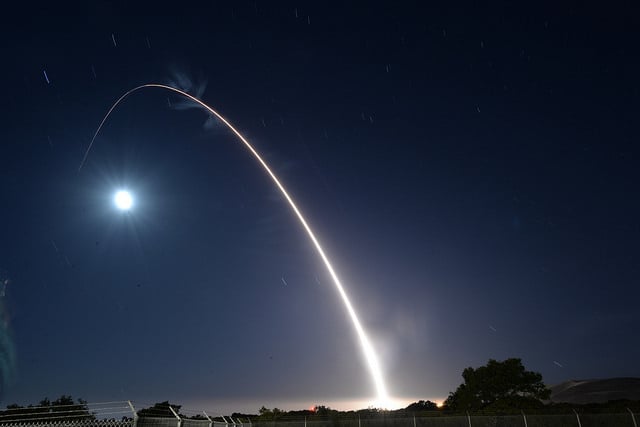
An Air Force Minuteman III ICBM launches during an operational test
WASHINGTON: The Biden administration is pushing ahead with multiple missile defense initiatives in its first 100 days, a sign the Pentagon will make new investments in the capability to meet developing Chinese, North Korean and Russian capabilities.
The announcement that the Pentagon awarded contracts to teams led by Northrop Grumman and Lockheed Martin to develop a Next Generation Interceptor to replace the aging interceptors currently in silos in California and Alaska comes as good news to missile defense advocates who have long said the current technology is in dire need of an upgrade.
The Tuesday awards, worth about $1.6 billion, will fund technology development for the program, with a potential value of $3.6 billion once the program is fielded. Boeing was the third competitor for one of the developmental contracts, but was not selected.
The announcement comes as Pentagon leadership is weighing a new push to build an Aegis Ashore missile defense system on Guam, something the Indo-Pacom commander has lobbied for the past several years, calling it his No. 1 priority. The command has asked for $350 million to start to work, and sources indicate that it might make its way into the 2022 budget expected to be released in May.
“The pursuit of NGI is responsive to strong warfighter demand and consistent with requirements validated” by the Joint Requirements Oversight Council, said Tom Karako, director of the Center for Strategic and International Security’s Missile Defense Project. “NGI breaks from the past by prioritizing capability over capacity but also with its conservative acquisition approach.”
The NGI effort kicked off in 2019 in the wake of the cancellation of a $5.8 billion effort to replace the existing Exo-Atmospheric Kill Vehicle, a ground-based interceptor designed to defend the US mainland against long-range ballistic missile attacks.
“The real differentiator here is the acquisition strategy, with a lot of competition — a lot of ‘fly before you buy’ — built in,” Karako added. “The relatively longer NGI development timeline for homeland ballistic missile defense can be mitigated by near-term improvements” in ground missile defense.
While NGI remains in development, “our overall missile defense and defeat posture can be reoriented to regional threats, specifically that of complex and integrated air and missile attack from the likes of China,” Karako said.
After weeks of defense officials warning that North Korea could re-start its missile testing program after a long hiatus, the country’s reclusive leader, Kin Jong-Un, ordered a test firing of what a Biden administration official called a “short-range” missile system last weekend. The official, speaking with reporters late Tuesday, said the missile type isn’t subject to U.N. Security Council resolutions. Because it falls under the threshold of what concerns the international community, the official said that “it probably gives you an indication of where it falls on the spectrum of concern.”
The Missile Defense Agency has estimated that testing of the NGI could happen by the mid-2020s, and if all goes well they could begin to be put into silos by 2028.
Air Force picks Anduril, General Atomics for next round of CCA work
The two vendors emerged successful from an original pool of five and are expected to carry their drone designs through a prototyping phase that will build and test aircraft.


























